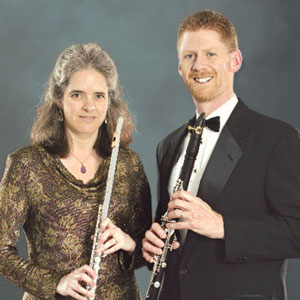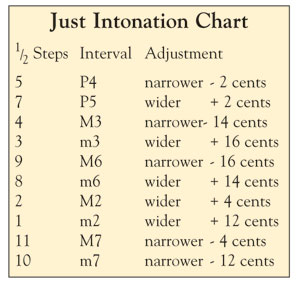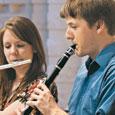 Combining the sounds of flute and clarinet creates an interesting ensemble. A flute and clarinet duo can also join easily with other instruments to form larger ensembles. Pairing these two instruments can be tricky however, because the instruments have several opposite inherent tendencies, and players may have very different playing styles.
Combining the sounds of flute and clarinet creates an interesting ensemble. A flute and clarinet duo can also join easily with other instruments to form larger ensembles. Pairing these two instruments can be tricky however, because the instruments have several opposite inherent tendencies, and players may have very different playing styles.
Vibrato
Flutists tend to use a great deal of vibrato while clarinetists use none or very little. The solution is to decide which passages require a blended organ-like sound with little vibrato and which ones are more soloistic. Flutists can use vibrato on the soloistic parts, which will provide the icing on the cake. However, the vibrato should not overwhelm the duo’s sound. Flutists can learn from clarinetists, who play so expressively with little or no vibrato.
Intonation
The flute can be flat when soft, and sharp when loud. The clarinet is the opposite: flat when loud, and sharp when soft. This opposite intonation-to-dynamic relationship is part of what makes this duo difficult. Both players should understand their instrument’s tendencies and work with a tuner to stay in tune while changing dynamics.
Practicing scales and melodies together is time well spent. When unisons sound in tune, work in octaves. You will be surprised at how much more difficult it is to play octaves in tune with a clarinet than it is to play them in tune with another flute. Another exercise is to choose a simple, familiar tune and have one person play it with in-tune melodic intervals. Then play it together; try transposing it to different keys.
Remember that registers also affect intonation differently, so listen carefully. Temperatures have an affect on intonation for both instruments, but in this case, the tendencies are the same. Both instruments go flat when they are cold, and sharp when they are warm.
Just Intonation
Intervals sound better when the notes are tuned in just-intonation instead of equal temperament. The Just Intonation Chart will help you learn to adjust intervals by ear. 
A perfect fifth, for example, sounds jangly or dissonant when both notes are in tune with a tuner because of the slightly audible difference tone clashes. A difference tone is the result of the mathematical difference between the frequencies of the two pitches. When the upper voice widens the interval slightly by raising the pitch, (just two cents, which equals two hundredths of a half step), the chord will sound consonant and beautiful.
Together, try making a perfect fifth sound pure in every key. Then play major thirds and bring the top note down fourteen cents to ring in tune. After working on perfect fifths and major thirds, try minor thirds. Later you can move on to those intervals that are less pure, such as seconds and sevenths.
(For standard repertoire and more on just intonation see “Blending Flutes and Clarinets,” Flute Talk, April 1996 by Leone Buyse, and “Intonation, Just and Tempered,” by Joanna Cowan Flute Talk, April 2002.)
Repertoire
For classical music to remain a living art, it is imperative that we expand the literature. Eager for new flute and clarinet works, many players commission new compositions. The selected works below were added to the repertoire in the last 15 years. Most are published, while others are available from the composers.
Flute and Clarinet Chamber Music (1994-2008), part 1
Rated for: A – Young student through high school; B – Advanced high school and college; C – College and professional
Armstrong, Joe & Leehay, Liz: Trans. of classical tunes; A (JB Linear Music-online)
Bach, J.S./Dorff, Daniel: A Treasury of Bach Duets; B, 2008.
Buss, H. J.: Time Capsule; B, 1996 (Brixton Publications)
Dorff, Daniel: Three Romances; B, 2007 (Tenuto Publications) The F-minot slow movement is the most difficult.
Dorff, Daniel: Two Cats; B, 2008 (Tenuto Pub.)
Froom, David: Circling; C, 2002 (composer); Recorded by the 21st Century Consort. effective and exciting.
Gottschalk, Arthur: Sonatina Casada; C 2000 (composer) Dedicated to Leone Buyse and Michael Webster. Latin dances; flashy and effective.
Grantham, Donald: New Mexico Twilight; C 2004 (Piquant Press). Changing meters and syncopation.
Gross, Murray: Folie à deux; C, 2005 (composer) intertwining lines; tongue stops for flute.
Harding, Scott R.: Four Short Dances, B, 2002 (C. Alan Publisher) commissioned by the Crescent Duo and premiered at the 2007 N.F.A. convention. The Air is unusual with the clarinet in the altissimo and the flute below in the reedy low register.
Harvey, Paul: The Summer Belles, A , 1994 (Fentone Music) A great choice for young groups.
Holcombe, Bill: Intermediate Jazz Etudes; B, 1995 (Musicians Publications) 12 pieces. Chord symbols used.
Kenney, Terry: Street-Wise; Duets for Flute and Clarinet; A, 2001 (Spartan Press) 9 short jazz duets in a written swing style.
Kelley, Daniel: Music for Two; A, 2000-02 (Last Resort Music) vols. 1 & 2 – Wedding Music and Classical Favorites; vol. 3 – Gilbert and Sullivan, Irish Music and Rags; vol. 4 – Waltzes, Fiddle Tunes, and Traditional Pop Favorites. Large selection of arrangements, clarinet parts are easier than the flute parts.
Kelley, Daniel: Intermediate Music for Two, Classical Favorites; A, 2004 (Last Resort Music) v. 1, 2, easier than volumes above.
Maúrtua, José-Luis: Les Trois “Tiques”; C 2002 (Watchdog Pres) Commissioned by Crescent Duo and premiered at the 2005 Intl. Clarinet Assoc. Conference; Cuban inspired and dazzling.
Mireles, Andres Aloy Rodriguez Mireles: Pajarillo a Duo, B, 2002 (composer) Pajarillo or “Little Bird,” is a Venezuelan joropo from the western plains of the country. Commissioned by the Crescent Duo.
Real, Nicolas: Danza Maracaibeada, B, 2002, (composer) Commissioned by Crescent Duo, written for flute with Bb clarinet, but works well with bass clarinet.
Resanovic, Nikola: Four Sketches; B, 2006, (composer) destined to become a repertoire standard, uses difference tones, Commissioned by Crescent Duo.
Parker, Philip: Games; B, 1995 (composer) winner of 1996 N.F.A. Newly Published Music Contest. Challenging and fun.
Pineda, Raimundo: Five Beats Up; B, 2002 (composer) A light, Venezuelan merengue in 5/8, commissioned by the Crescent Duo.
Schekman, Joel: Duos aus Schoenberg’s Zeit; C, 2002-08, written for Schekman to play with Judith Kemph, lengthy, intricate, and effective.
Schocker, Gary: Airheads; B, 2000 (Theodore Presser) Already a popular classic, commissioned by Michele Gingras and Sandra Seefeldt.
Tanguay, Eric: Duet; C, 1994 (Salabert) In NFA Library. Dissonance and complex rhythms.
Uyeda, Leslie: Like Near Misses, C, 2008 (The Avondale Press) Rhythmically difficult and lyrical.
Vogel, Alan: Mythic Quest and Twin Moons; B, 1997 (Brixton Publications) Two one-movement works.
Welcher, Dan: Reversible Jackets, Exercises in Conjugal Counterpoint; B, 1997 (Elkan-Vogel) A wedding gift for Leone Buyse and Michael Webster.
Flute and Clarinet with Electronic Sounds (may include piano)
Bimstein, Phillip: Half Moon at Checkerboard Messa; C, 1997 (Franklin Stark Music) Colorful sounds.
Bimstein, Phillip: The Golden Duel; B, 1997 (Franklin Stark Music) With optional crystal bowl.
Mazurek, Ron: A Time To…for trio and tape; C, 2004 (Calabrese Brothers Music) With piano anf recorded sounds, Commissioned by Esther Lamneck. Effective, calm alternating with motion.
Flute, Clarinet, Voice or Narrator, and Piano
Barab, Seymour: Willie Was Different; B, 1995 (Seesaw Music) Text by Norman Rockwell; based on children’s book.
Barab, Seymour: The Sea Princess; B, 2005 (composer) Based on Hans Christian Andersen’s The Little Mermaid, written for the Palisades Virtuosi.
Blank, Allan, Four Poems by Emily Dickinson, C, 1998 (International Opus)
McMichael, Catherine: Dog Chronicles; B, 2007 (Alry Publications) Texts by Mark Twain, Lord Byron and others, enjoyable, commissioned by Windsong and premiered in Washington D.C. in 2007.
Recent Duo Recordings
(listed by title, performers,
composers,& label)
Woodwind Echoes, Crescent Duo: works by Resanovic, Harding, Maurtua, Real, Pineda, Mireles, (White Pine Music)
Flights of Fancy, Crescent Duo: works by Rutter, David, Liptak, Dietz, Sloan, Szalowski (Centaur Records)
Rivier Revisited, Buyse/Webster Duo, Rivier, (Crystal Records)
Fleeting Visions, Collaboration II, Buyse/Webster Duo, work by Gottschalk, A. (Beauport Classical)
Chamber Music With Flute, performed by Pahud, Lesage, Meyer, works by Jolivet and Villa-Lobos (EMI)
Flute Loops, Chamber Music by Cynthia Folio, performers Kelly and Demers (Centaur Records)
Kupferman, O North Star, Maurer/Harlow [Kupferman] Soundspell.
Contra-Punctus, Folio/Thompson, works by Folio (Society of Composers)
Giacinto Scelsi: Complete Works for Flute and Clarinet, Ebony Duo (Col Legno)
Giacinto Scelsi: Complete Works for Clarinet, Mohr/Smeyers (Radio Bremen)
Giacinto Scelsi, Music for High Winds, Robinson/Novakova (Mode)
Froom: Song and Dance, performed by Stern/Cigan (Bridge Records)
Music for a Sunday Afternoon, performers Maurer/Harlow, works by Kraft and Muczynski (4Tay)
Elliot Carter, Nouvel Ensemble Moderne (Atma Classique)
Clarinet Now, Stallman and Brezniak, work by Gould (Centaur Records)
Villa-Lobos Woodwind Music, Bondi and Ellis (EtCetera Records)
Jack’s Fat Cat: Carl Vollrath, Finegold and Stolzman (MMC Recordings)





